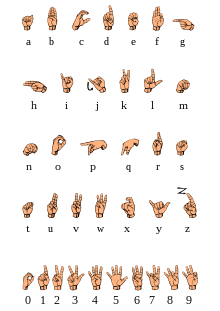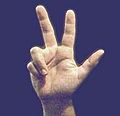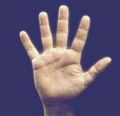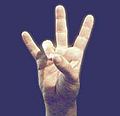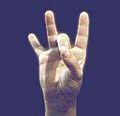
American Sign Language (ASL) is a natural language that serves as the predominant sign language of deaf communities in the United States and most of Anglophone Canada. ASL is a complete and organized visual language that is expressed by employing both manual and nonmanual features. Besides North America, dialects of ASL and ASL-based creoles are used in many countries around the world, including much of West Africa and parts of Southeast Asia. ASL is also widely learned as a second language, serving as a lingua franca. ASL is most closely related to French Sign Language (LSF). It has been proposed that ASL is a creole language of LSF, although ASL shows features atypical of creole languages, such as agglutinative morphology.

Fingerspelling is the representation of the letters of a writing system, and sometimes numeral systems, using only the hands. These manual alphabets have often been used in deaf education and have subsequently been adopted as a distinct part of a number of sign languages. There are about forty manual alphabets around the world. Historically, manual alphabets have had a number of additional applications—including use as ciphers, as mnemonics and in silent religious settings.

Sign languages are languages that use the visual-manual modality to convey meaning, instead of spoken words. Sign languages are expressed through manual articulation in combination with non-manual markers. Sign languages are full-fledged natural languages with their own grammar and lexicon. Sign languages are not universal and are usually not mutually intelligible, although there are also similarities among different sign languages.
Sutton SignWriting, or simply SignWriting, is a system of writing sign languages. It is highly featural and visually iconic, both in the shapes of the characters, which are abstract pictures of the hands, face, and body, and in their spatial arrangement on the page, which does not follow a sequential order like the letters that make up written English words. It was developed in 1974 by Valerie Sutton, a dancer who had, two years earlier, developed DanceWriting. Some newer standardized forms are known as the International Sign Writing Alphabet (ISWA).
Auslan is the sign language used by the majority of the Australian Deaf community. The term Auslan is a portmanteau of "Australian Sign Language", coined by Trevor Johnston in the 1980s, although the language itself is much older. Auslan is related to British Sign Language (BSL) and New Zealand Sign Language (NZSL); the three have descended from the same parent language, and together comprise the BANZSL language family. Auslan has also been influenced by Irish Sign Language (ISL) and more recently has borrowed signs from American Sign Language (ASL).
Signing Exact English is a system of manual communication that strives to be an exact representation of English language vocabulary and grammar. It is one of a number of such systems in use in English-speaking countries. It is related to Seeing Essential English (SEE-I), a manual sign system created in 1945, based on the morphemes of English words. SEE-II models much of its sign vocabulary from American Sign Language (ASL), but modifies the handshapes used in ASL in order to use the handshape of the first letter of the corresponding English word.
Several manual alphabets in use around the world employ two hands to represent some or all of the letters of an alphabet, usually as a part of a deaf sign language. Two-handed alphabets are less widespread than one-handed manual alphabets. They may be used to represent the Latin alphabet or the Cyrillic alphabet.
Tactile signing is a common means of communication used by people with deafblindness. It is based on a sign language or another system of manual communication.
Manually Coded English (MCE) is an umbrella term referring to a number of invented manual codes intended to visually represent the exact grammar and morphology of spoken English. Different codes of MCE vary in the levels of adherence to spoken English grammar, morphology, and syntax. MCE is typically used in conjunction with direct spoken English.

Stokoe notation is the first phonemic script used for sign languages. It was created by William Stokoe for American Sign Language (ASL), with Latin letters and numerals used for the shapes they have in fingerspelling, and iconic glyphs to transcribe the position, movement, and orientation of the hands. It was first published as the organizing principle of Sign Language Structure: An Outline of the Visual Communication Systems of the American Deaf (1960), and later also used in A Dictionary of American Sign Language on Linguistic Principles, by Stokoe, Casterline, and Croneberg (1965). In the 1965 dictionary, signs are themselves arranged alphabetically, according to their Stokoe transcription, rather than being ordered by their English glosses as in other sign-language dictionaries. This made it the only ASL dictionary where the reader could look up a sign without first knowing how to translate it into English. The Stokoe notation was later adapted to British Sign Language (BSL) in Kyle et al. (1985) and to Australian Aboriginal sign languages in Kendon (1988). In each case the researchers modified the alphabet to accommodate phonemes not found in ASL.

In deaf culture and sign language, a sign name is a special sign that is used to uniquely identify a person.
American Sign Language (ASL), the sign language used by the deaf community throughout most of North America, has a rich vocabulary of terms, which include profanity. Within deaf culture, there is a distinction drawn between signs used to curse versus signs that are used to describe sexual acts. In usage, signs to describe detailed sexual behavior are highly taboo due to their graphic nature. As for the signs themselves, some signs do overlap, but they may also vary according to usage. For example, the sign for "shit" when used to curse is different from the sign for "shit" when used to describe the bodily function or the fecal matter.
In sign languages, handshape, or dez, refers to the distinctive configurations that the hands take as they are used to form words. In Stokoe terminology it is known as the DEZ, an abbreviation of designator. Handshape is one of five components of a sign, along with location, orientation, movement, and nonmanual features. Different sign languages make use of different handshapes.
Argentine Sign Language is used in Argentina. Deaf people attend separate schools, and use local sign languages out of class. A manual alphabet for spelling Spanish has been developed.
The grammar of American Sign Language (ASL) has rules just like any other sign language or spoken language. ASL grammar studies date back to William Stokoe in the 1960s. This sign language consists of parameters that determine many other grammar rules. Typical word structure in ASL conforms to the SVO/OSV and topic-comment form, supplemented by a noun-adjective order and time-sequenced ordering of clauses. ASL has large CP and DP syntax systems, and also doesn't contain many conjunctions like some other languages do.
American Sign Language literature is one of the most important shared cultural experiences in the American deaf community. Literary genres initially developed in residential Deaf institutes, such as American School for the Deaf in Hartford, Connecticut, which is where American Sign Language developed as a language in the early 19th century. There are many genres of ASL literature, such as narratives of personal experience, poetry, cinematographic stories, folktales, translated works, original fiction and stories with handshape constraints. Authors of ASL literature use their body as the text of their work, which is visually read and comprehended by their audience viewers. In the early development of ASL literary genres, the works were generally not analyzed as written texts are, but the increased dissemination of ASL literature on video has led to greater analysis of these genres.
Nepalese Sign Language or Nepali Sign Language is the main sign language of Nepal. It is a partially standardized language based informally on the variety used in Kathmandu, with some input from varieties from Pokhara and elsewhere. As an indigenous sign language, it is not related to oral Nepali. The Nepali Constitution of 2015 specifically mentions the right to have education in Sign Language for the deaf. Likewise, the newly passed Disability Rights Act of 2072 BS defined language to include "spoken and sign languages and other forms of speechless language." in practice it is recognized by the Ministry of Education and the Ministry of Women, Children and Social Welfare, and is used in all schools for the deaf. In addition, there is legislation underway in Nepal which, in line with the UN Convention on the Rights of Persons with Disabilities (UNCRPD) which Nepal has ratified, should give Nepalese Sign Language equal status with the oral languages of the country.
In sign language, an initialized sign is one that is produced with a handshape(s) that corresponds to the fingerspelling of its equivalent in the locally dominant oral language, based on the respective manual alphabet representing that oral language's orthography. The handshape(s) of these signs then represent the initial letter of their written equivalent(s). In some cases, this is due to the local oral language having more than one equivalent to a basic sign. For example, in ASL, the signs for "class" and "family" are the same, except that "class" is signed with a 'C' handshape, and "family" with an 'F' handshape. In other cases initialization is required for disambiguation, though the signs are not semantically related. For example, in ASL, "water" it signed with a 'W' handshape touching the mouth, while "dentist" is similar apart from using a 'D' handshape. In other cases initialization is not used for disambiguation; the ASL sign for "elevator", for example, is an 'E' handshape moving up and down along the upright index finger of the other hand.
Sign languages such as American Sign Language (ASL) are characterized by phonological processes analogous to, yet dissimilar from, those of oral languages. Although there is a qualitative difference from oral languages in that sign-language phonemes are not based on sound, and are spatial in addition to being temporal, they fulfill the same role as phonemes in oral languages.

An Esperanto manual alphabet is included as part of the Signuno project for manually coded Esperanto. Signuno is based on the signs of International Sign, but adapted to the grammatical system of Esperanto.
